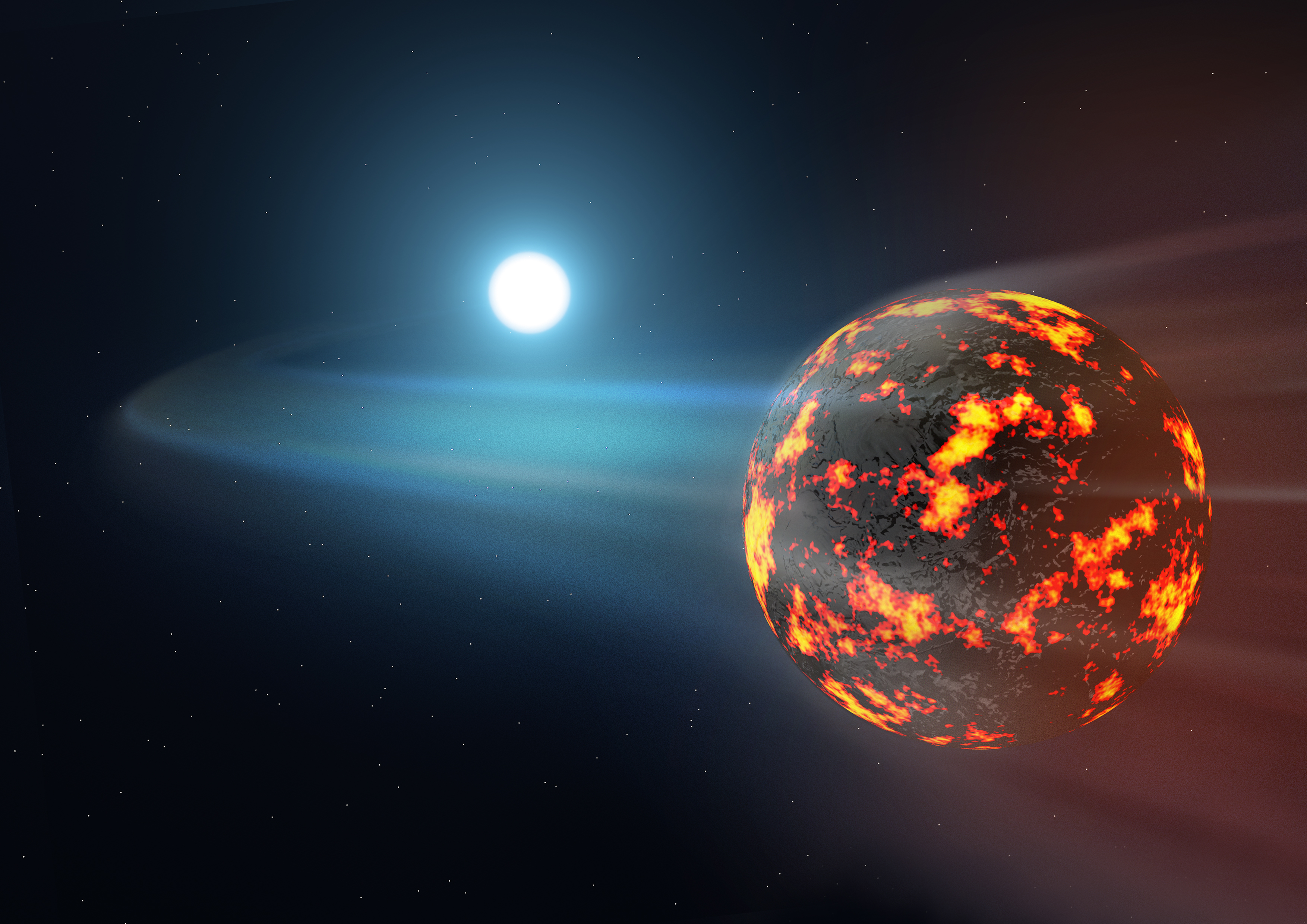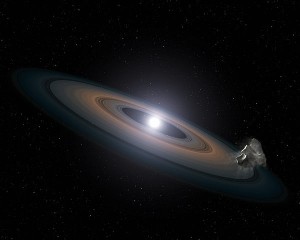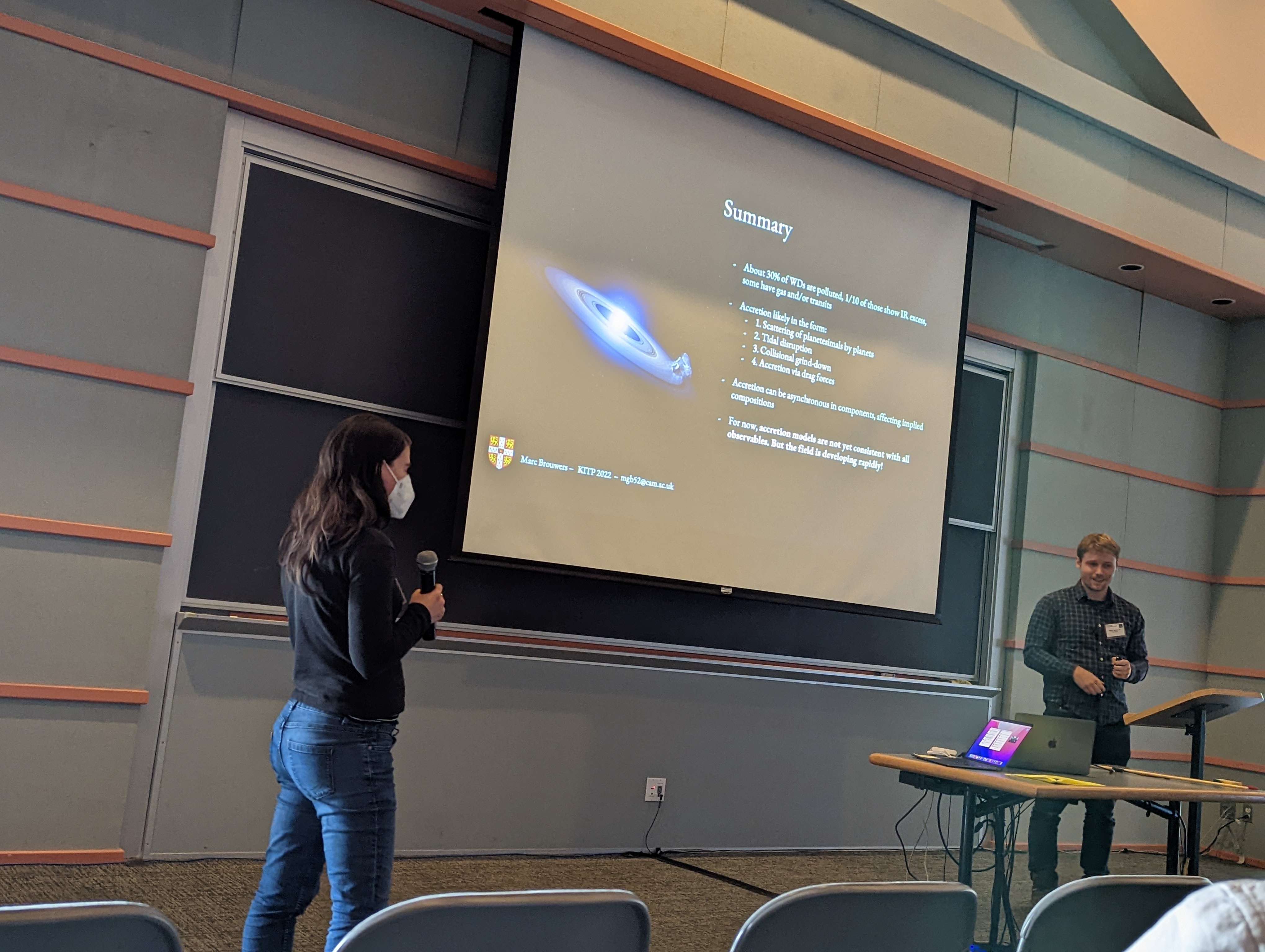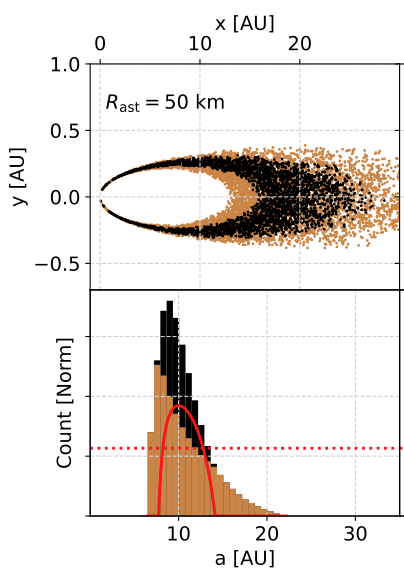Publications
Anslow R.~J., Bonsor A., Todd Z.~R., Wordsworth R., Rae A.~S.~P., McDonald C.~H., Rimmer P.~B., The atmospheric entry of cometary impactors, 2025, MNRAS, 539, 376.
pdf
Anslow, R.~J., Bonsor, A., Rimmer, P.~B., Rae, A.~S.~P., McDonald, C.~H., Walton, C.~R., 2025., The plausibility of origins scenarios requiring two impactors., Proceedings of the Royal Society of London Series A 481. pdf
Aguilera-G{\'o}mez C., Rogers L.~K., Bonsor A., Jofr{\'e} P., Blouin S., Shorttle O., Buchan A.~M., et al.,Host star and exoplanet composition: Polluted white \
dwarf reveals depletion of moderately refractory elements in planetary material. 2025, A\&A, 693, A64
pdf
Badenas-Agusti M., Xu S., Vanderburg A., De K., Dufour P., Rogers L.~K., Hoyos S., et al., A machine-learning compositional study of exoplanetary material accreted onto five helium-atmosphere white dwarfs with cecilia., 2025, MNRAS, 540, 746. pdf
Li, Y., Bonsor, A., Shorttle, O., Rogers, L.~K., 2025., Can tidal evolution lead to close-in planetary bodies around white dwarfs - I. Orbital period distribution., MNRAS, 537, 2214–2231 pdf
Li, Y., Bonsor, A., Shorttle, O., 2025.,Can tidal evolution lead to close-in planetary bodies around white dwarfs II: volcanism and transits, MNRAS, pdf
Rogers L.~K., Manser C.~J., Bonsor A., Dennihy E., Hodgkin S., Kissler-Patig M., Lai S., et al., 2024, Simultaneous emission from dust and gas in the planetary debris orbiting a white dwarf pdf
Byrne, X., Bonsor, A., Rogers, L.~K., Manser, C
.~J., 2024., Semi-supervised spectral classification of DESI white dwarfs by dimensionality reduction, MNRAS, 535, 2246–2259 pdf
Bonsor, A., 2024, White Dwarf Systems: the Composition of Exoplanets, Chapter of Encyclopedia of Astrophy
sics' (Editor-in-Chief Ilya Mandel, Section Editor Dimitri Veras pdf
Rogers L.~K., Bonsor A., Xu S., Buchan A.~M., Dufour P., Klein B.~L., Hodgkin S., et al., 2024, Seven White Dwarfs with circumestellar gas discs II: tracing the composition of exoplanetary building blocks, MNRAS, 532, 3866 pdf
Buchan A.~M., Bonsor A., Rogers L.~K., Brouwers M.~G., Shorttle O., Tremblay P.-E., 2024, White Dwarf constraints on geological processes at the population level, MNRAS, 532, 2705 pdf
Kao M.~L., Hawkins K., Rogers L.~K., Bonsor A., Dunlap B.~H., Sanders J.~L., Montgomery M.~H., et al., 2024,Hunting for Polluted\
White Dwarfs and Other Treasures with Gaia XP Spectra and Unsupervised Machine Learning, ApJ, 970, 181 pdf press release\
Madurga Favieres C., Kissler-Patig M., Xu S., Bonsor A., 2024, A catalog of 554 white dwarfs showing infrared excess from Gaia ED\
R3 and CatWISE catalogsA\&A, 688, A168. pdf
Veras D., Mustill A.~J., Bonsor A., 2024,The evolution and delivery of rocky extra-solar materials to white dwarfs, RvMG, 90, 14\
1 pdf
Casewell, S.~L. et al (inc Bonsor, A.), 2024, PHL 5038AB: Is the brown dwarf causing pollution of its white dwarf host star?, M\
NRAS, MNRAS, 530, 3302. pdf
Rogers L.~K., Bonsor A., Xu S., Dufour P., Klein B.~L., Buchan A., Hodgkin S., et al., 2024, Seven white dwarfs with circumstellar gas discs I: white dwarf parameters and accreted planetary abundances, MNRAS, 527, 6038 \
pdf
Li, Y., Bonsor, A., Shorttle, O., 2024, Post-main sequence thermal evolution of planetesimals, MNRAS, 527, 1014–1032. pdf
Rogers, L.~K., Debes, J., Anslow, R., Bonsor, A. et al 2024, WD 0141-675: a case study on how to follow-up astrometric planet candidates around white dwarfs, MNRA\
S 527, 977–990 pdf
Anslow, R.~J., Bonsor, A., Rimmer, P.~B.\ 2023.\ Can comets deliver prebiotic molecules to rocky exoplanets?.\ Proceedings of the Royal Society of London Series A 479 pdf
Bonsor, A., Wyatt, M.~C., Marino, S., Davidsson, B.~J.~R., Kral, Q., Thebault, P.\ 2023.\ Secondary gas in debris discs released following the decay of long-lived \
radioactive nuclides, catastrophic or resurfacing collisions, MNRAS 526, 3115–3129 pdf
Brouwers M.~G., Buchan A.~M., Bonsor A., Malamud U., Lynch E., Rogers L., Koester D., Asynchronous accretion can mimic diverse white dwarf pollutants II: water content, MNRAS, 519, 2663–2679, 2023, pdf
Brouwers, M.~G., Bonsor, A., Malamud, U., Asynchronous accretion can mimic diverse white dwarf pollutants I: core and mantle fragments, MNRAS,519, 2, 2646-2662, 2023 pdf
Brouwers, M., A matter of life and death: the formation and destruction of planetary systems, PhD Thesis pdf
Bonsor, A., Lictenberg, T., Drazdowska, J., Buchan, A., The early formation of exoplanetesimals, as revealed by white dwrafs, Nature Astronomy, in press pdf
Lovell, J., Wyatt, M.C., Kalap, P., Kennedy, G.M., Marino, S., Bonsor, A., Penoyre, Z., Fulton, B.J., Pawellek, N., High-resolution ALMA and HST imaging of Kappa Cr B: a broad debris disc around a post-main-sequence star with low mass companions, 2022, MNRAS, 517, 2546 pdf
Sanderson, H., Bonsor, A., Mustill, A., Can Gaia find planets around white dwarfs?, 2022, MNRAS, 517, 5835 pdf
Curry, A., Bonsor, A., Lichtenberg, T., Shorttle, O., Prevalence of short-lived radioacitve isotopes across exoplanetary systems inferred from polluted white dwarfs, MNRAS, 515, 395 pdf
Buchan, A., Bonsor, A., Shorrtle, O., Wade, J., Harrison, J., Noack, L., Koester, D., Planets or asteroids? A geochemical method to constrain the masses of White Dwarf pollutants, 2022, MNRAS,510, 3512 pdf
Brouwers, M. G., Bonsor, A., Malamud, U. A road-map to white dwarf pollution: tidal disruption, eccentric grind-down and dust accretion, 2022, MNRAS, 509, 2404 pdf
Kral, Q., Pringle, J.E., Guilber-Lepoutre, A.,Matra, L., Moses, J.I., Lellouch, E., Wyatt, M.C., Biver, N., Bockelee-Morvan, D., Bonsor, A., Le Petit, F., Randall Gladstone, G., A molecular wind blows out of the Kuiper belt, 2021, A&A, 653, 14 pdf
Xu, S., Bonsor, A., Exogeneology from White Dwarfs, Elements, pdf
Brouwers, M. G., Ormel, C. W., Bonsor, A., Vazan, A., How
planets grow by pebble accretion IV: Envelope opacity trends from
sedimenting dust and pebbles, A&A, in press pdf
Lai, Samuel, Dennihy, Erik, Xu, Siyi, Nitta, Atsuko, Kleinman,
Scot, Leggett, S. K., Bonsor, Amy, Hodgkin, Simon,
Rebassa-Mansergas, Alberto, Rogers, Laura K., Infrared Excesses
around Bright White Dwarfs from Gaia and unWISE. II, ApJ in press pdf
Absil, O., Marion, L., Ertel, S., Defrère, D., Kennedy, G. M., Romagnolo, A.,
Le Bouquin, J. -B., Christiaens, V., Milli, J., Bonsor, A.,
Olofsson, J., Su, K. Y. L., Augereau, J. -C., A
near-infrared interferometric survey of debris-disk stars. VII. The
hot-to-warm dust connection, A&A, 651, 29 pdf
Harrison, J.H.D., Bonsor, A.,Kama, M., Buchan, A., Blouin, S., Bayesian constraints on the origin and geology of exo-planetary material using a population of externally polluted white dwarfs, MN
RAS, 504, 2853pdf Supplementary Information One
Bonsor, A., Jofré, P, Shorttle, O., Rogers, L. K., Xu, S., Melis, C., Host-star and exoplanet compositions: a pilot study using a wide binary with a polluted white dwarf, 2021, MNRAS, 503,1877
pdf
Harrison, J., Shorttle, O., Bonsor, A., Evidence for Post-nebula Volatisation in an Exoplanetary Body, 2020, EPSL, 554, 116694 pdf
Dennihy, Erik, Xu, Siyi, Lai, Samuel, Bonsor,
Amy , Clemens, J.~C., Dufour, Patrick et al,, Five New
Post-Main-Sequence Debris Disks with Gaseous Emission, ApJ, 905, 16 pdf
Harrison, J.H.D, Polluted White Dwarfs: Insights into Ancient Extrasolar Planetary Systems, PhD Thesis pdf
Rogers, Laura K., Xu, Siyi, Bonsor, Amy , Hodgkin, Simon, Su, Kate Y. L., von Hippel, Ted, Jura, Michael, Near-infrared variability in dusty white dwarfs: tracing the accretion of planetary material, MNRAS, 494,2, 2861 pdf
Amy Bonsor, Philip J Carter, Mark Hollands, Boris T Gansicke, Zoe Leinhardt, John HD Harrison, Are Exoplanetesimals differentiated?, MNRAS, 492,2, 2683pdf
Dorn, C., Harrison, J.H.D., Bonsor, Amy , Hands ,T.O., A new class of Super-Earths formed from high-temperature condensates: HD219134 b, 55 Cnc e, WASP-47 e, MNRAS, 484, 712, pdf
Xu, S., Su, K. Y.L., Rogers, Bonsor, A. , Olofsson, J., Veras, D., van Lieshout, R., Infrared Variability of Two Dusty White Dwarfs, 2018, ApJ, 866 (2) 108pdf
Bonsor, A. , Wyatt, M.C., Kral, Q., Kennedy, G., Shannon, A., Ertel, S., Using warm dust to constrain unseen planets, 2018, MNRAS, 480 (4) 5560-5579pd
Farihi, J., van Leishout, R., Cauley, P.W., Dennohy, E., Su, K.Y.L,, Kenyon, S.J., G Wilson, O Toloza, BT Gänsicke, T von Hippel, S Redfield, JH Debes, S Xu, L Rogers, A Bonsor , A Swan, AF Pala, WT Reach, Dust production and depletion in evolved planetary systems, 2018, MNRAS, 481 (2) 2601-2611pd
Harrison, J., Bonsor, A., Madhusudhan, N.
Polluted White Dwarfs: Constraints on the Origin and Geology of
Exoplanetary Material, 2018, MNRAS, 479 (3) 3814-3841 pdf
Marino, S. , Bonsor, A., Wyatt, M.C., Kral, Q.
Scattering of exocoments by a planet chain: exozodi levels and the delivery of cometary material to inner planets, 2018, MNRAS, 479,1651-1671 pdf
Wyatt, M. C., Bonsor, A., Jackson, A. P., Marino, S., Shannon, A.
How to design a planetary system for different scattering outcomes: giant impact sweet spot, maximizing exocomets, scattered discs, MNRAS, 464, 3385 pdf
Xu, S., Bonsor, A., White Dwarf Planetary Systems: insights regarding the fate of planetary systems pdf
Bonsor, A. , Farihi, J., Wyatt, M. C., Van Lieshout, R., Infrared observations of white dwarfs and the implications for the accretion of dusty planetary material, MNRAS, 468, 154 pdf
Marino, S., Wyatt, M. C., Panic, O., Matra, L., Kennedy, G. M., Bonsor, A., Kral, Q., Dent, W. R. F, Duchene, G., Wilner, D., ALMA observations of the $eta$ Corvi debris disc: inward scattering of CO-rich exocomets by a chain of 3-30 Mearth planets?, MNRAS, accepted pdf
Shannon, A., Bonsor, A., Kral, Q., Matthews, E., The unseen planets of double belt debris disk systems, MNRAS, 2016, 462, 116 pdf
Bonsor, A., Veras, D., A wide binary trigger for white dwarf pollution, MNRAS, 2015, 454, 53 pdf
June 2014 - June 2015 Maternity Leave
Veras, D., Leinhardt, Z. M., Bonsor, A., Gaensicke, B. T., Formation of planetary debris discs around white dwarfs - I. Tidal disruption of an extremely eccentric asteroid, MNRAS, 2014, 445, 2224 pdf
Farihi,J., Wyatt,M.C., Greaves,J.S., Bonsor, A., Sibthorpe, B., Panic, O., ALMA and Herschel observations of the prototype dusty and polluted white dwarf G29-38, MNRAS,2014,444, 1821 pdf
Bonsor, A., Leinhardt, Z. M., Carter, P.J., Elliot, T., Walter, M.J., Stewart, S. T., A Collisional Origin to Earth's Non-chondritic Composition?, Icarus,2014, 247, 291 pdf
Ertel,S., Absil,O., Defrere,D., Le Bouquin, J.-B ., Augereau, J.-C., Marion,L., Blind,N., Bonsor, A., Bryden, G., Lebreton, J., Milli, J.,A near-infrared interferometric survey of debris-disk stars. IV. An unbiased sample of 92 southern stars observed in H band with VLTI/PIONIER, A&A, 2014, 570, 128 pdf
Raymond, S., Bonsor, A., Vega's hot dust from icy planetesimals scattered inward by an outward-migrating planetary system, MNRAS, 2014, 444, 18 pdf
Bonsor, A., Raymond, S., Augereau, J.-C., Ormel, C., Planetesimal driven migration as an explanation for observations of high levels of warm, exozodiacal dust, MNRAS, 2014, 441, 2380 pdf
Jackson, A. P., Wyatt, M. C., Bonsor, A. & Veras, D., Debris froms giant impacts between planetary embryos at large orbital radi, MNRAS, 2014, 440, 3757-3777 pdf
Faramaz, V., Beust, H., Thebault, P., Augereau, J.-C., Bonsor, A., del Burgo, C., Ertel, S., Marshall, J. P., Milli, J., Montesinos, B., Mora, A., Bryden, G., Danchi, W., Eiroa, C., White, G. J
. & Wolf, S., Can eccentric debris disks be long-lived?. A first numerical investigation and application to zeta2 Reticuli, A&A, 2014, 563, A72 pdf
Bonsor, A., Kennedy, G. M., Wyatt, M. C., Johnson, J. A. & Sibthorpe, B., Herschel observations of debris discs orbiting planet-hosting subgiants, MNRAS, 2014, 437, 3288 pdf
Wyatt, M. C., Farihi, J., Pringle, J. E. & Bonsor, A., Stochastic accretion of planetesimals on to white dwarfs: constraints on the mass distribution of accreted material from atmospheric pollution, MNRAS, 2014, 439, 3371 pdf
Beust, H., Augereau, J.-C.,Bonsor, A., Graham, J. R., Kalas, P., Lebreton, J., Lagrange, A.-M., Ertel, S., Faramaz, V. & Thébault, P., An independent determination of Fomalhaut b's orbit and the dynamical effects on the outer dust belt, A&A, 2014, 561, A43 pdf
Bonsor, A., Raymond, S., Augereau, J.-C., The short-lived production of exozodiacal dust in the aftermath of a
dynamical instability in planetary systems, MNRAS, 2013,433, 2938, pdf
Bonsor, A., Kennedy, G. Crepp, J., Johnson, J., Wyatt, M.C. and Sibthorpe, B, Spatially Resolved Images of Dust Belt(s) Around the Planet-hosting Subgiant Kappa CrB, MNRAS, 431, 3025-3035pdf
Veras, D., Mustill, A. J., Bonsor, A., Wyatt, M.C., Simulations of two-planet systems through all phases of stellar evolution: implications for the instability boundary and white dwarf pollution, MNRAS, 431,1686-1708, pdf
Su, K. Y. L., Rieke, G. H., Malhotra, R., Stapelfeldt, K. R., Hughes, M., Bonsor, A., Wilner,
D. J., Balog, Z., Watson, D. M., Werner, M. W., Misselt, K. A., Asteroid belts in debris disk twins: Vega and Fomalhaut, ApJ, 763, 118 pdf
Bonsor, A., Augereau J.-C., & Thebault, P., 2012, Scattering of small bodies by planets: a potential origin for exozodiacal dust?, A&A, in press, pdf
THESIS Bonsor, Amy, October 2011, 'Post-main Sequence Evolution of Planetary Systems' pdf
Bonsor, A., Wyatt, M.C., 2011,'The scattering of small bodies in planetary systems: constraints on the possible orbits of cometary material.', MNRAS,420, 2990, pdf
Veras, Dimitri, Wyatt, Mark C., Mustill, Alexander J., Bonsor, Amy, Eldridge, John J.,'The great escape: how exoplanets and smaller bodies desert dying stars', MNRAS, 417, 104, pdf
Bonsor, A., Mustill, A. J., Wyatt, M.C., 2010, 'Dynamical effects of stellar mass loss on Kuiper-like belts.', MNRAS, 414, 930. pdf
Bonsor & Wyatt, 2010,'Post-main-sequence evolution of A star debris discs', MNRAS, 409, 1631. pdf








 Credit: NASA, ESA, STScI, and G. Bacon (STScI)
Credit: NASA, ESA, STScI, and G. Bacon (STScI) July 2025, Summer punting
July 2025, Summer punting July 2024, Summer punting
July 2024, Summer punting June 2024 Siyi Xu and Chris Manser visit the IoA
June 2024 Siyi Xu and Chris Manser visit the IoA Celebrating Marc Brouwer's Viva
Celebrating Marc Brouwer's Viva 17th November, 2022, Marc Brouwers giving a talk at the KITP Meeting, White Dwarfs from Physics to Astrophysics
17th November, 2022, Marc Brouwers giving a talk at the KITP Meeting, White Dwarfs from Physics to Astrophysics  11th November, 2022,
Asychronous accretion onto
white dwarfs, Brouwers et al,
2022, published in MNRAS
11th November, 2022,
Asychronous accretion onto
white dwarfs, Brouwers et al,
2022, published in MNRAS  Congratulations to Dr Rogers on receipt of her PhD
Congratulations to Dr Rogers on receipt of her PhD  Tim Cunningham, University of Warwick, visits our group. Lots of interesting science discussions, X-rays detected from accreting white dwarfs and a bicyle ride.
Tim Cunningham, University of Warwick, visits our group. Lots of interesting science discussions, X-rays detected from accreting white dwarfs and a bicyle ride.